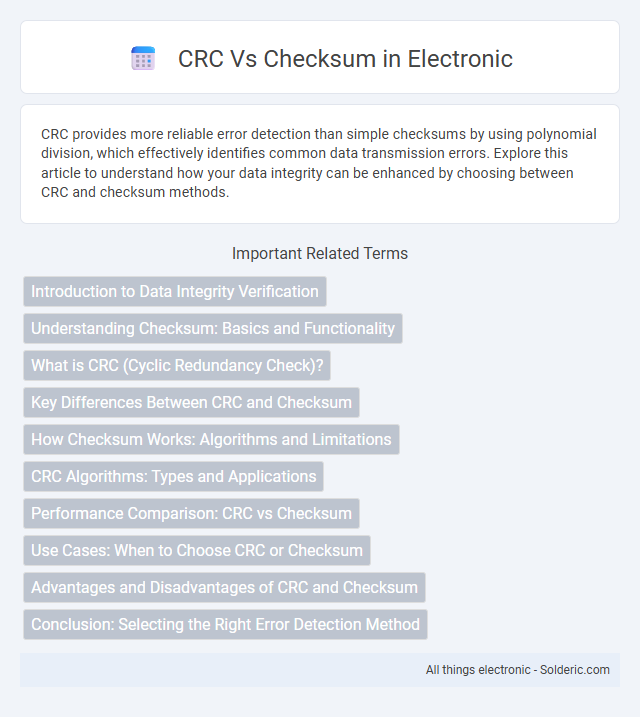CRC provides more reliable error detection than simple checksums by using polynomial division, which effectively identifies common data transmission errors. Explore this article to understand how your data integrity can be enhanced by choosing between CRC and checksum methods.
Comparison Table
| Feature | CRC (Cyclic Redundancy Check) | Checksum |
|---|---|---|
| Purpose | Error detection in digital networks and storage devices | Simple error detection in data transmission |
| Algorithm | Polynomial division algorithm | Arithmetic addition of data units |
| Error Detection Capability | High (detects burst errors, multiple bit errors) | Moderate (detects single bit errors, less robust) |
| Complexity | Higher computational complexity | Lower computational complexity |
| Use Cases | Network protocols (Ethernet, USB), storage media | Simple protocols, checksum verification in files |
| Output | Fixed-length binary sequence (e.g., 16, 32 bits) | Variable-length numeric sum |
Introduction to Data Integrity Verification
CRC (Cyclic Redundancy Check) and Checksum are essential techniques for data integrity verification, detecting errors during data transmission or storage. CRC employs polynomial division to produce a unique code, offering higher reliability in error detection compared to simple checksum methods that sum data values. Ensuring your data's accuracy with CRC or checksum safeguards information from corruption and enhances communication system robustness.
Understanding Checksum: Basics and Functionality
Checksum is a simple error-detection method that calculates a fixed-size value from a data block using a basic arithmetic or logical operation, primarily to detect accidental errors in data transmission or storage. It operates by summing the binary values of the data segments and generating a unique checksum value that is appended to the data for verification upon receipt. Unlike more complex methods like CRC (Cyclic Redundancy Check), checksum is faster but less reliable in detecting certain types of errors, making it suitable for simpler or less critical applications.
What is CRC (Cyclic Redundancy Check)?
CRC (Cyclic Redundancy Check) is an error-detecting code used to identify accidental changes to raw data in digital networks and storage devices. It operates by performing polynomial division on the data bits, generating a fixed-size checksum that can be verified upon data retrieval or transmission. CRC is more reliable than simple checksums, as it can detect common types of errors such as single-bit flips, burst errors, and some multi-bit errors.
Key Differences Between CRC and Checksum
CRC (Cyclic Redundancy Check) offers stronger error detection capabilities than checksum by using polynomial division to detect burst errors, while checksum simply adds data values to produce a simple sum for error checking. CRC generates a fixed-size hash based on message contents, making it more reliable for detecting complex errors in data transmission, whereas checksum is faster but less robust, suitable for detecting accidental data corruption. The algorithmic complexity of CRC is higher, requiring more computational resources compared to the simpler and faster checksum calculations.
How Checksum Works: Algorithms and Limitations
Checksum algorithms work by summing the binary values of data segments to produce a fixed-size hash used for error detection in data transmission. Common methods include simple additive sums and cyclic algorithms that provide basic integrity checks but are limited in detecting complex errors such as burst errors or intentional tampering. Your choice of checksum must consider these limitations, as more robust alternatives like CRC offer stronger error detection capabilities by employing polynomial division techniques.
CRC Algorithms: Types and Applications
CRC algorithms include popular types such as CRC-32, CRC-16, and CRC-8, each designed for varying levels of error detection efficiency and computational complexity. These algorithms are widely applied in network communications, storage devices, and digital data transmission to detect accidental changes to raw data. Robust error detection with CRC methods surpasses basic checksum techniques by utilizing polynomial division, making CRC indispensable in protocols like Ethernet and USB.
Performance Comparison: CRC vs Checksum
CRC offers stronger error detection capabilities than checksum by using polynomial division, making it more reliable for detecting burst errors. Checksum is computationally faster and simpler, suitable for applications where speed is critical but error detection needs are less stringent. Your choice depends on whether performance priority lies in speed (checksum) or accuracy and robustness (CRC).
Use Cases: When to Choose CRC or Checksum
CRC is ideal for detecting accidental data corruption in communication protocols, storage devices, and network transmissions due to its high error-detection capabilities. Checksum suits simpler applications like file integrity verification, basic error detection in files or downloads, and less critical data transfers where speed is prioritized over accuracy. Your choice depends on the required error-detection strength: opt for CRC in reliability-critical systems and checksum for lightweight, performance-sensitive tasks.
Advantages and Disadvantages of CRC and Checksum
CRC (Cyclic Redundancy Check) offers superior error detection capabilities compared to checksums, particularly in identifying burst errors, making it ideal for network communications and data storage. However, CRC implementation requires more complex hardware or software resources, increasing computational overhead and latency. Checksums are simpler and faster to compute, suitable for detecting random errors in less critical applications, but they have lower reliability in detecting more complex error patterns.
Conclusion: Selecting the Right Error Detection Method
Cyclic Redundancy Check (CRC) offers superior error detection capabilities compared to simple checksums, making it ideal for applications requiring high data integrity, such as network communications and storage devices. Checksums, while faster and computationally less demanding, provide basic error detection suitable for less critical data verification tasks. Choosing between CRC and checksum depends on factors like error detection accuracy, computational resources, and specific use case requirements.
CRC vs Checksum Infographic

 solderic.com
solderic.com